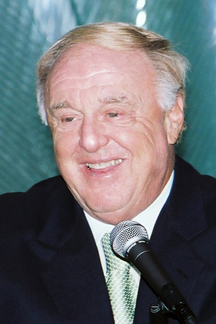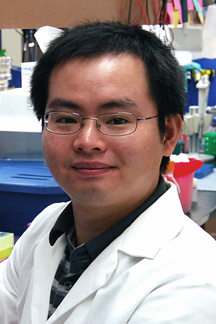Team Finds Better Way to Engineer Therapeutic Proteins into Antibodies
Some proteins exist so fleetingly in the bloodstream that they can’t be given effectively as therapies. However, building them into larger proteins, such as antibodies, can make them persist long enough to be useful. Now a team led by scientists at The Scripps Research Institute (TSRI) has devised an improved method for accomplishing this protein-engineering feat.
The new method mimics evolution by generating millions of possible junction segments between the inserted protein and its antibody host, selecting the rare ones that allow the inserted protein to fold and function normally. The technique should speed the development of drug and diagnostic compounds that would not have been possible otherwise—including powerful hormone-based therapies.
“Unlike prior approaches to this design problem, ours is a selection-based method—and it’s hard to beat this approach, with its ability to harness the power of very large numbers,” said senior investigator Richard A. Lerner, the Lita Annenberg Hazen Professor of Immunochemistry at TSRI.
The technique is general enough so it could have many clinical and scientific applications, for example, determining why proteins fold as they do. “It effectively enables you to put a measuring device in the middle of a protein to determine if it’s folded properly,” Lerner said.
The study, a collaboration between Lerner’s laboratory at TSRI, the laboratory of Jeffrey M. Friedman at Rockefeller University and the TSRI groups of Ian A. Wilson and Patrick R. Griffin, was reported on August 13 in the journal Chemistry & Biology.
Making Leptin Last Longer
Lerner’s laboratory helped pioneer techniques for generating billions of different antibodies and screening these large “antibody libraries” to find those that perform a desired function. The new work is an extension of that technology.
In one proof-of-principle demonstration, the team edited the genetic code of a standard human antibody to replace one of its target-grappling elements—a structure that normally would bind to a virus, for example—with the protein leptin.
First identified by Friedman in 1994 as a satiety hormone that switches off hunger, leptin initially failed as an obesity therapy, as obese people tend to be insensitive to leptin rather than leptin-deficient. However, the hormone has drawn renewed interest in recent years as a possible basis for treating obesity—in conjunction with leptin-sensitizing compounds—and also diabetes.
Leptin on its own and in an unmodified state isn’t ideal as a therapy because it doesn’t last long in the bloodstream. “The kidneys and other organs clear it very rapidly,” said Yingjie Peng, a staff scientist in the Lerner laboratory who was first author of the study with Wenwen Zeng of Friedman’s lab at Rockefeller. “But it could last much longer if it were part of a larger structure such as an antibody.”
The major challenge for Lerner, Peng and their colleagues was to design leptin into an antibody in such a way that it would fold up into a functional structure despite being bound to its host protein at either end.
Designing simple, highly flexible “junction” segments to join leptin to an antibody could work—a recent paper by a group including TSRI’s Peter Schultz, Scripps Family Chair Professor of Chemistry, described such a feat.
But Lerner’s team reasoned that a selection-based design of these junctions would be a more general approach to making useful protein-in-protein molecules.
The Power of Large Numbers
Using their established techniques for generating large libraries of variant antibodies, the team made nearly 30 million versions of the leptin-in-antibody protein, each version having a different amino-acid sequence for its junction segments.
To find the rare versions that enabled leptin to fold up and function properly, the researchers used a selection system that they had previously developed for finding therapeutic antibodies in large antibody libraries. First they employed viral vectors to insert the leptin-in-antibody DNA into test cells that contain leptin receptors. When one of the resulting leptin-in- antibody proteins successfully activated a leptin receptor in its test cell, the event was signaled by a highly sensitive set of fluorescent beacons.
The cells whose beacon signals rose above a certain threshold were analyzed for the leptin-in-antibody DNA they contained, and this DNA was then inserted into new test cells—and so on, for round after round of selection, until the process yielded the leptin-in-antibody protein that did best at activating the leptin receptor.
This selected protein turned out to be several times more potent than leptin in terms of its ability to activate the leptin receptor in cultured cells. In tests in Friedman’s laboratory, it had a more than a four-hour bloodstream half-life in mice—a big improvement over natural leptin.
As is often the case for antibodies, the leptin-in-antibody protein effectively could not cross from the bloodstream into the brain and thus could not hit all of leptin’s neuronal targets—and so its effects at reducing eating and weight in mice were less than optimal. But, in principle, antibodies can be modified to enable them to cross the blood-brain barrier more easily, and the team is working on that now.
Broad Applications
To highlight the general applicability of the new method, the researchers also used it to “selection-design” an antibody that incorporates the growth and reproductive hormone FSH—which is structurally very different from leptin. The resulting FSH-in-antibody protein showed activity against the FSH receptor that was virtually the same as the natural hormone’s.
The team is now working to improve their FSH- and leptin-in-antibody proteins, and to design entirely new protein-in-antibody molecules.
In addition to Lerner, Friedman, Wilson, Griffin, Peng and Zheng, other co-authors of the paper, “A General Method for Insertion of Functional Proteins Within Proteins Via Combinatorial Selection of Permissive Junctions,” were Hui Ye, Kyung Ho Han, Venkatasubramanian Dharmarajan and Scott Novick, all of TSRI during the study. See http://www.cell.com/chemistry-biology/abstract/S1074-5521(15)00285-9
Funding for the research was provided in part by the JPB Foundation and Zebra Biologics, Inc.
Send comments to: press[at]scripps.edu















